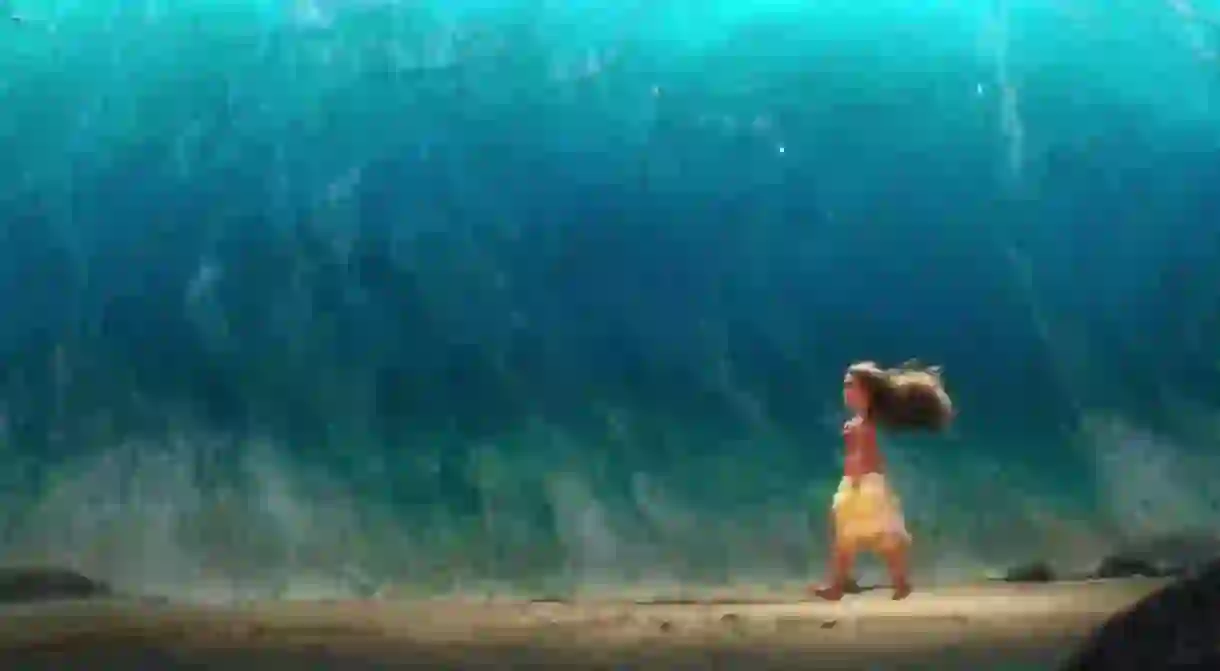10 Ways Hawaii Inspired Disney's "Moana"

The minute that Auli’i Cravalho—a Hawaiian native—was cast as the lead of Disney’s Moana, it was inevitable that Hawaii’s rich culture would find its way into the movie. Although the movie’s highlights borrow from many different places and histories of Pasifika, the nods to Hawaii are very much welcomed and present in these 10 ways.
Wayfaring
The Hawaiian Islands themselves were founded on a history of wayfaring. Polynesians, who were natural travelers and settlers, voyaged and discovered these islands in the Pacific. They decided to stay and to build new homes and new lives and, for centuries, the native Hawaiians continued the tradition while navigating the ocean. Using only the guidance of stars from the night sky as well as winds and currents, the Hawaiians were able to explore and trade in waters far from home. This was an ever-present theme throughout Moana as she fancied herself a new kind of voyager.

The ocean
The personification of Ocean in the beloved Disney film is true to the culture and beliefs of the Hawaiian people. The phrase “Never turn your back on the ocean” is still used today, and repeated to even those coming merely for a visit. Like most local Hawaiians, Moana feels a deep relationship to the ocean and considers it to be a guiding force. The beautiful idea that the ocean itself is a living, breathing, key character in each person’s narrative is so true to Hawaii.

Legend of Māui
Though some were unhappy with Maui’s physical depiction in the movie, it’s important to note that Māui’s role in mythology is different depending on which Pacific island you refer to. Most of what is depicted in Moana is the Maori legend of Maui. Some, however, is lent from Hawaiian mythology—like Maui’s brag in the song “You’re Welcome”. He sings about pulling down the sun to stretch out the day and dragging the islands up from the sea, which are still present and significant in Hawaiian origin stories passed through generations.

Hula
One of the first things people think of when Hawaii is mentioned is the art of hula. Visitors travel from all over the world to watch hula performances on beachfront resorts. Lesser known to travelers is the meaning behind hula for the Hawaiian people. Hula boasts a long history in the original religion of the islands. In the film, Moana’s grandmother, Tala, performs a graceful hula by the sea. As Moana joins her, it becomes a bonding and important moment for both of them. True to its original meaning for the Hawaiian people, the hula is a passing of knowledge and ideals.

‘Aumakua
The ‘aumakua is the spirit of an ancestor who presents themselves in animal form. ‘Aumakua are guardians that are meant to protect and guide those still living, like Moana’s relationship with her grandmother. The tear-inducing scenes of Moana’s grandmother passing and coming back as her favorite animal, the stingray, embodies this very important Hawaiian belief.

Haka
With other Pacific Island origins, haka isn’t particularly Hawaiian, but Hawaii did adopt its own version of the Maori ‘haka’. In Moana, the Demi-god Maui performs this in order to enter Lalotai and retrieve his hook from the “crabulous” Tamatoa. This could very well have been a symbol of his challenge to Tamatoa, staying true to the purpose of this beloved war dance.

Costumes
The attention to detail in this film is mesmerizing–just look at the stitching patterns on the ‘kapa’, or barkcloth. The textures are truly reminiscent of their inspired cultures. Even small adjustments to looks—like Moana putting her hair up in a bun when she’s getting down to business—resonates with the Hawaiian community. Disney really pulled out all the stops in their creativity to promote Polynesian cultures in the best way they knew how. And though maybe some of us wish they didn’t have to lump so many cultures into one movie, the blend they created was respectful and captivating at the same time.

Sustainable living
Hawaii continues to promote sustainable living practices and encourages taking care of the land—even more so than many other U.S. states. It’s one of the key Hawaiian values on these islands. This is mirrored in the film’s song about how the island offers everything that the village needs. Moana’s father tells her to “consider the coconut” and all it can give to sustain life on the island. Perhaps he wasn’t necessarily right to ban fishing past the reef, but her father did what he thought was best.

Respect for gender diversity
Though the concept of Moana becoming a chief is up for debate among those of Polynesian lineage, the Hawaiian culture historically respects gender diversity. The depiction of Moana as the future chief is an empowering message and quite exemplary of Hawaiian practices. The idea that Moana doesn’t need a prince or king to become the leader of her people is very easy to get behind.

The rooster
Hei hei, the beloved rooster companion of Moana, was a last minute addition. When the writers traveled throughout the South Pacific to gain inspiration and knowledge into the complicated and ancient cultures on these islands, they found one interesting thing in common. Each time they landed on a new island, the constant would be roosters and chickens strutting around everywhere.














